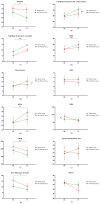Effectiveness of Two Models of Telerehabilitation in Improving Recovery from Subacute Upper Limb Disability after Stroke: Robotic vs. Non-Robotic
- PMID: 39335435
- PMCID: PMC11430637
- DOI: 10.3390/brainsci14090941
Effectiveness of Two Models of Telerehabilitation in Improving Recovery from Subacute Upper Limb Disability after Stroke: Robotic vs. Non-Robotic
Abstract
Background/objectives: Finding innovative digital solutions is fundamental to ensure prompt and continuous care for patients with chronic neurological disorders, whose demand for rehabilitation also in home-based settings is steadily increasing. The aim is to verify the safety and the effectiveness of two telerehabilitation (TR) models in improving recovery from subacute upper limb (UL) disability after stroke, with and without a robotic device.
Methods: One hundred nineteen subjects with subacute post-stroke UL disability were assessed for eligibility. Of them, 30 patients were enrolled in the study and randomly assigned to either the Robotic Group (RG), undergoing a 20-session TR program, using a robotic device, or the Non-Robotic Group (NRG), undergoing a 20-session TR program without robotics. Clinical evaluations were measured at baseline (T0) and post-intervention (T1, 5 weeks after baseline), and included assessments of quality of life, motor skills, and clinical/functional status. The primary outcome measure was the World Health Organization Disability Assessment Schedule 2.0, evaluating the change in perceived disability.
Results: Statistical analysis shows that patients of both groups improved significantly over time in all domains analyzed (mean decrease from baseline in the WHODAS 2.0 of 6.09 ± 2.62% for the NRG, and of 0.76 ± 2.21% for the RG), with a greater improvement of patients in the NRG in motor (Fugl-Meyer Assessment Upper Extremity-motor function, Box and Block Test) and cognitive skills (Trail Making Test-A).
Conclusions: This study highlights the potential of TR programs to transform stroke rehabilitation by enhancing accessibility and patient-centered care, promoting autonomy, improving adherence, and leading to better outcomes and quality of life for stroke survivors.
Keywords: home-based; rehabilitation; rehabilitation protocol; robot-assisted rehabilitation training; robotics; stroke; telehealth; upper extremity; virtual reality.
Conflict of interest statement
The authors declare no conflict of interest.
Figures



References
-
- Camussi E., Meneghetti D., Sbarra M.L., Rella R., Barillà F., Sassi C., Montali L., Annovazzi C. COVID-19, people with disabilities, and the Italian government recovery: Investigating the impact and promoting psychological resources to prevent future emergencies. Front. Psychol. 2023;14:1260853. doi: 10.3389/fpsyg.2023.1260853. - DOI - PMC - PubMed
-
- Feigin V.L., Nichols E., Alam T., Bannick M.S., Beghi E., Blake N., Culpepper W.J., Dorsey E.R., Elbaz A., Ellenbogen R.G., et al. Global, regional, and national burden of neurological disorders, 1990–2016: A systematic analysis for the Global Burden of Disease Study 2016. Lancet Neurol. 2019;18:459–480. doi: 10.1016/S1474-4422(18)30499-X. - DOI - PMC - PubMed
-
- Cieza A., Causey K., Kamenov K., Hanson S.W., Chatterji S., Vos T. Global estimates of the need for rehabilitation based on the Global Burden of Disease study 2019: A systematic analysis for the Global Burden of Disease Study 2019. Lancet. 2020;396:2006–2017. doi: 10.1016/S0140-6736(20)32340-0. - DOI - PMC - PubMed
Grants and funding
LinkOut - more resources
Full Text Sources

